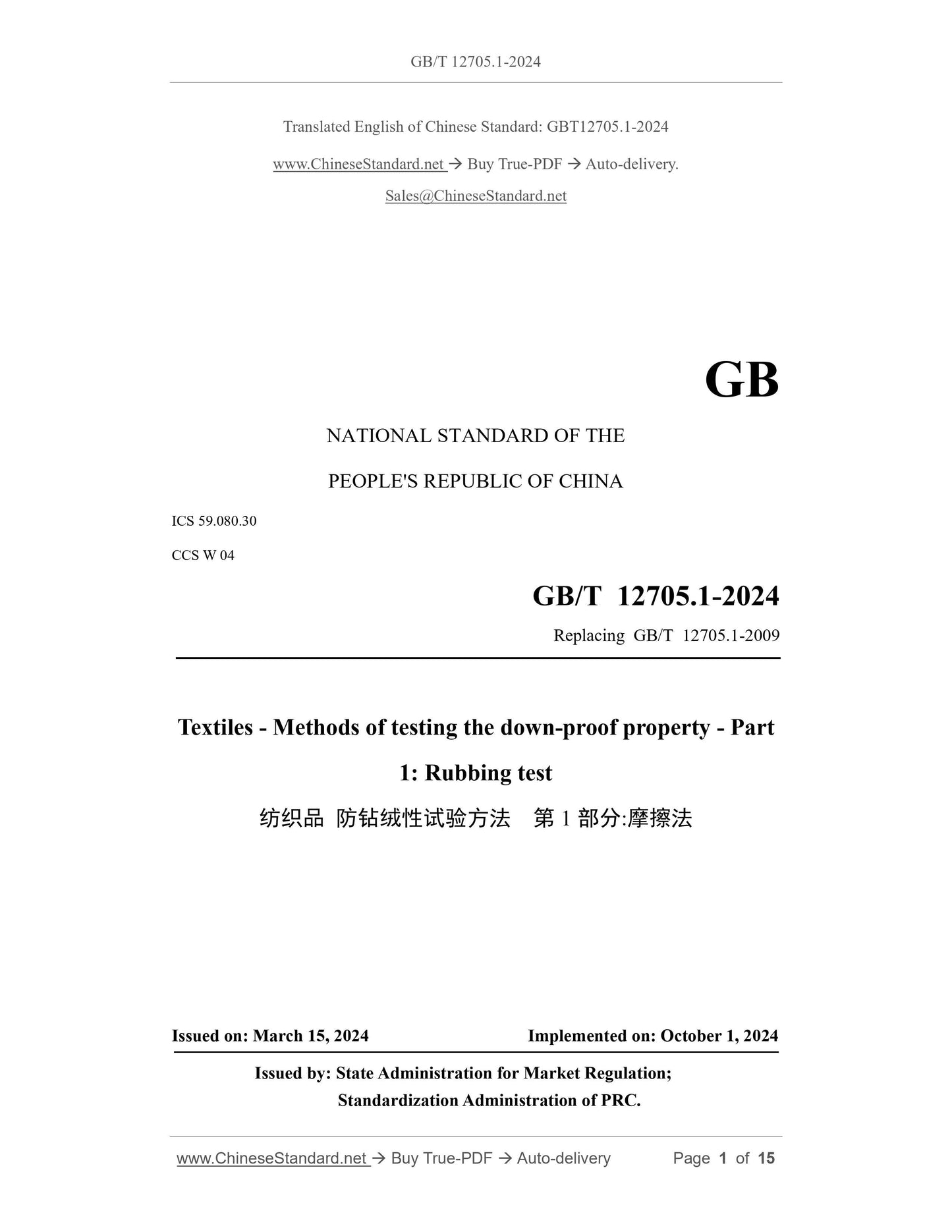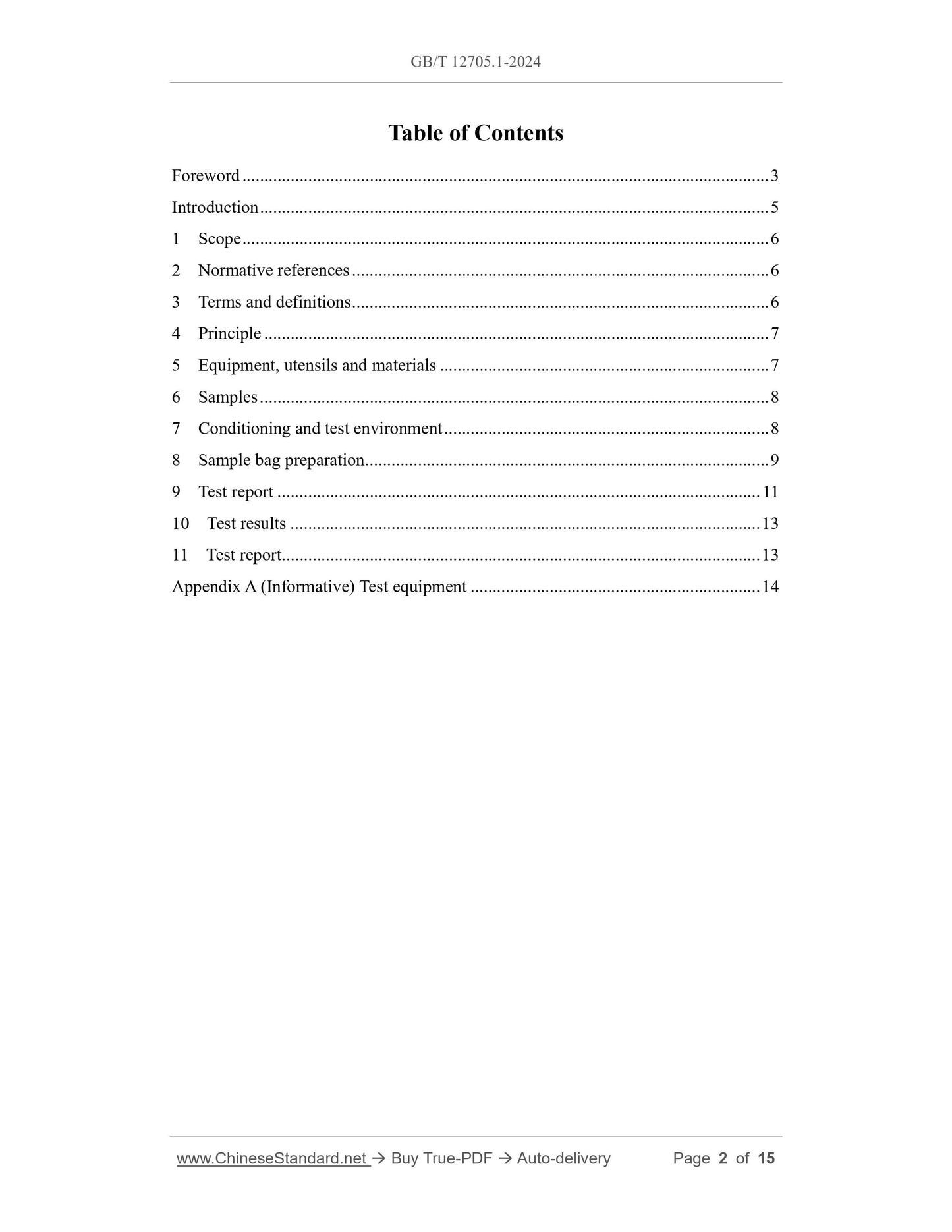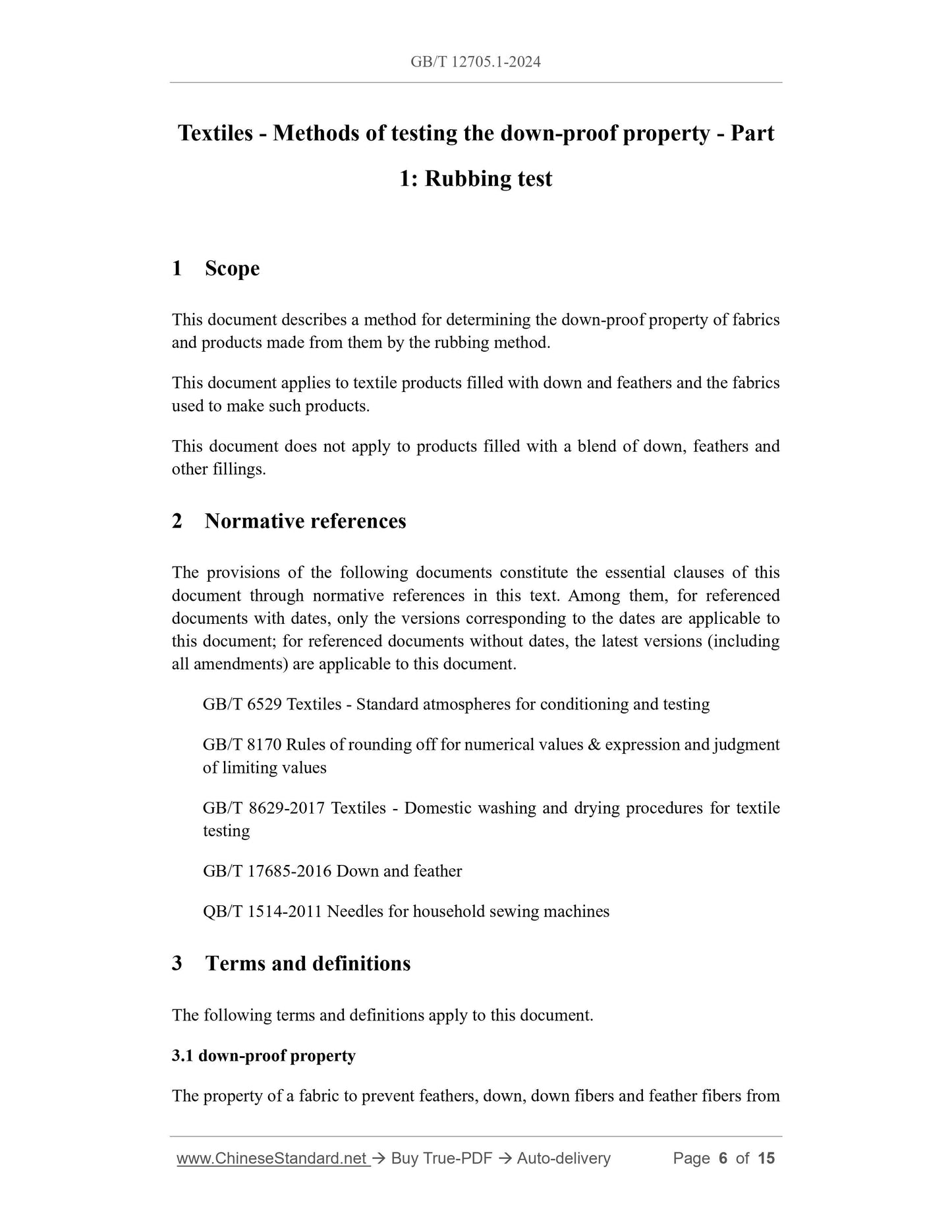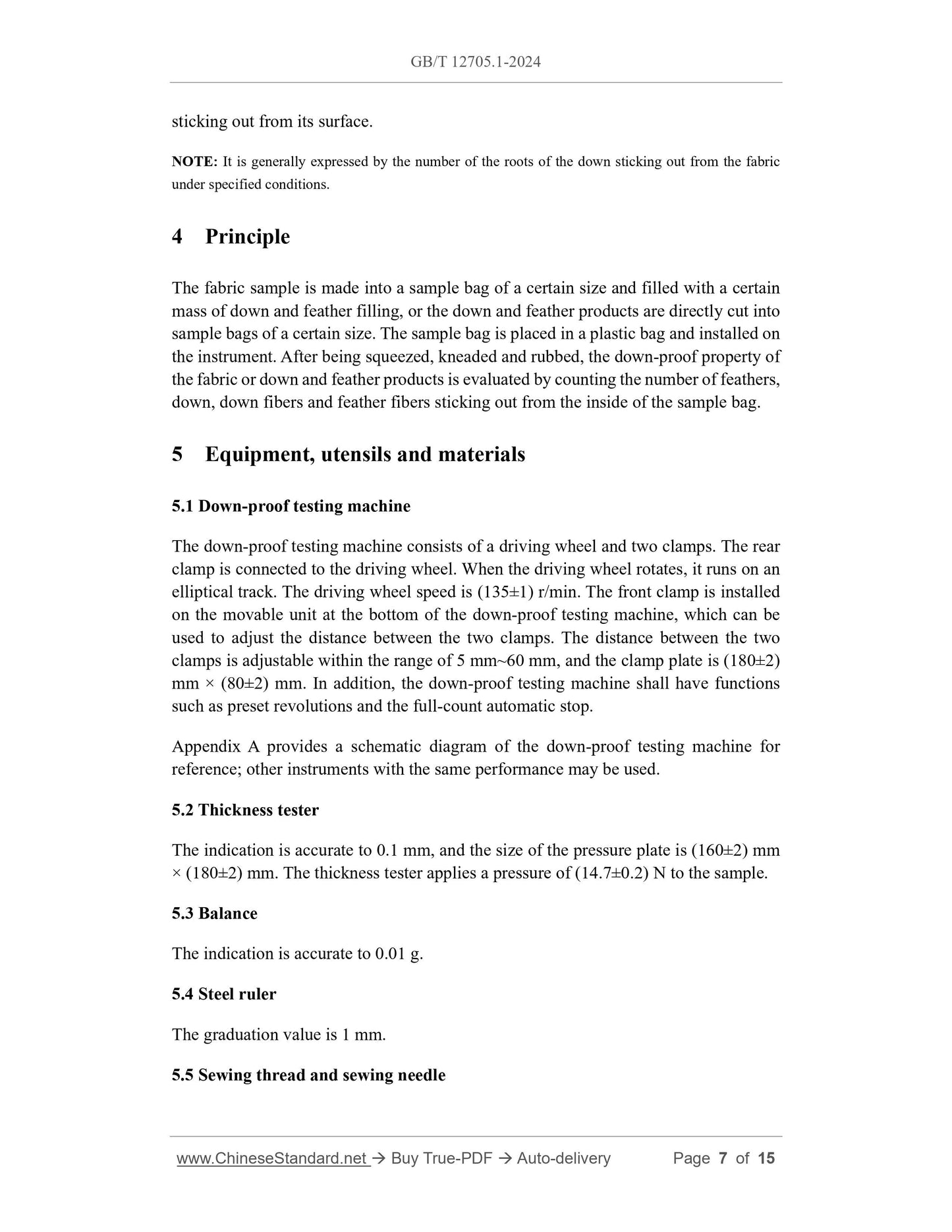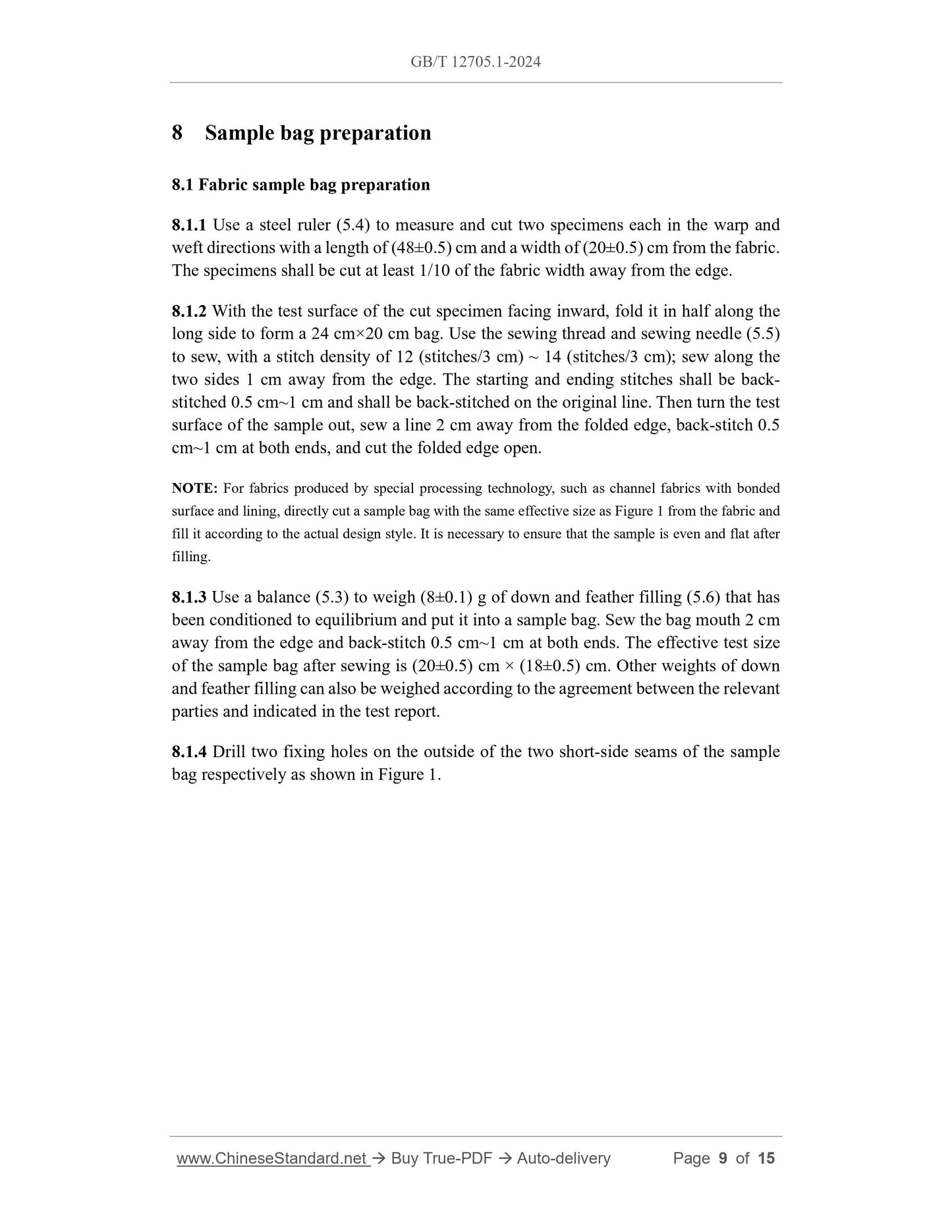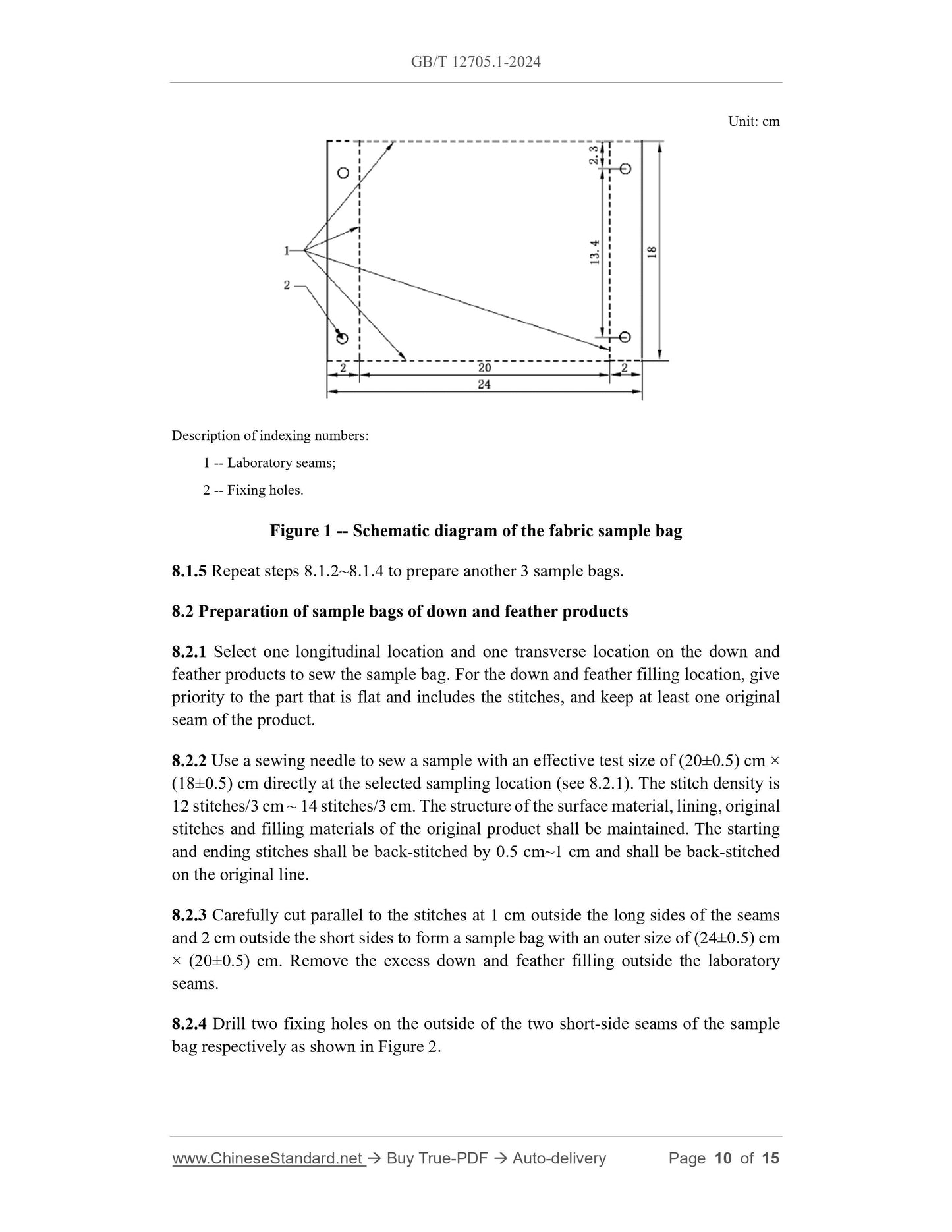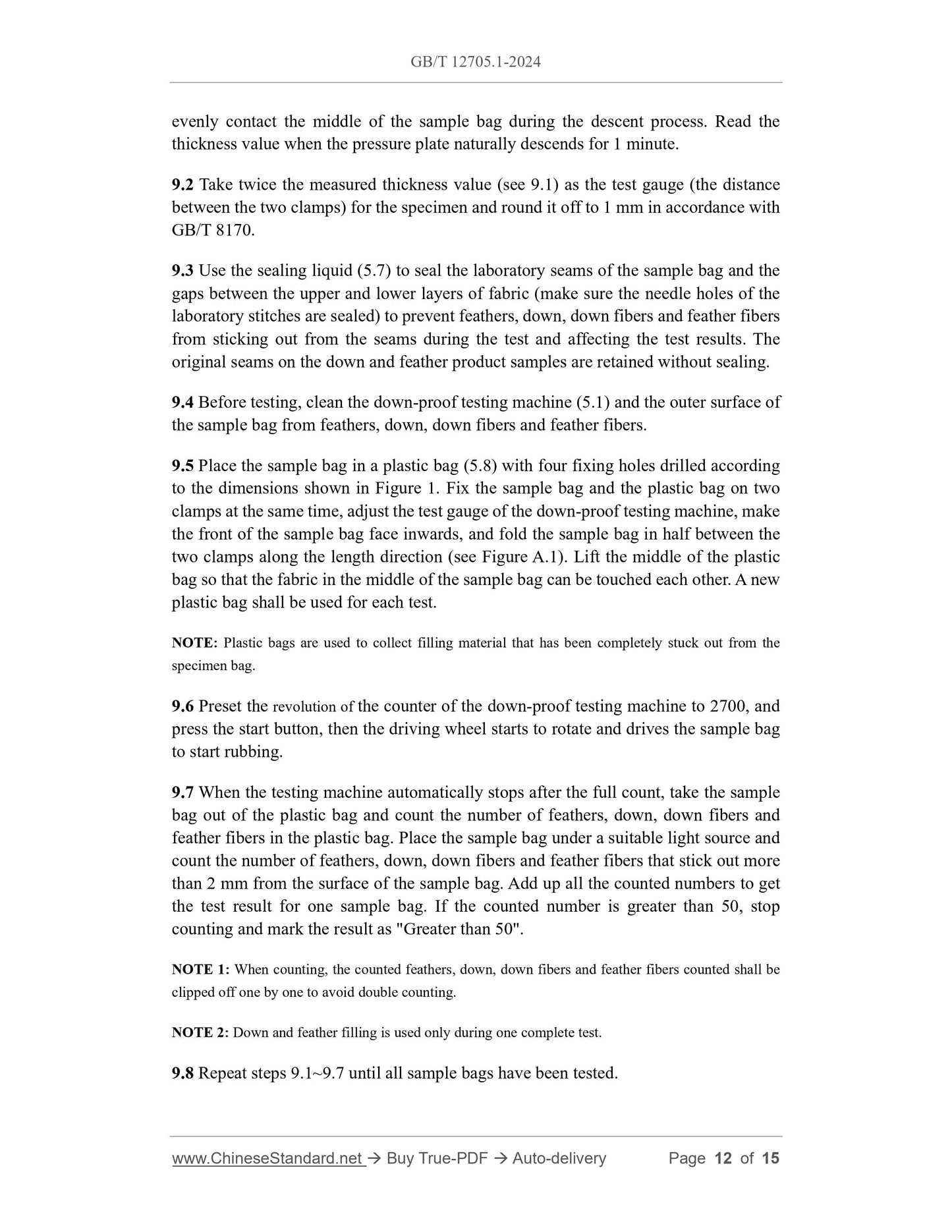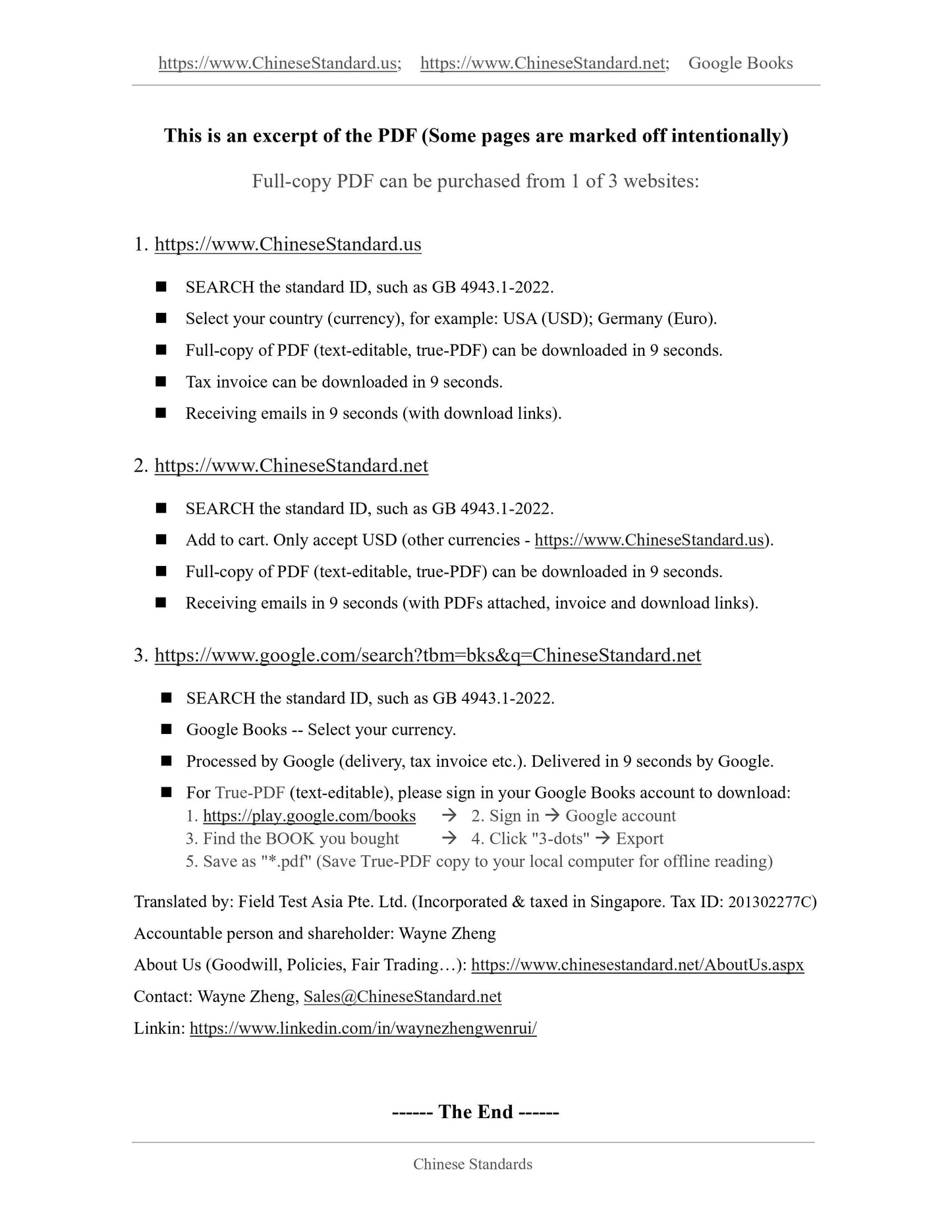1
/
of
8
PayPal, credit cards. Download editable-PDF and invoice in 1 second!
GB/T 12705.1-2024 English PDF (GBT12705.1-2024)
GB/T 12705.1-2024 English PDF (GBT12705.1-2024)
Regular price
$200.00 USD
Regular price
Sale price
$200.00 USD
Unit price
/
per
Shipping calculated at checkout.
Couldn't load pickup availability
Delivery: 3 seconds. Download true-PDF + Invoice.
Get QUOTATION in 1-minute: Click GB/T 12705.1-2024
Historical versions: GB/T 12705.1-2024
Preview True-PDF (Reload/Scroll if blank)
GB/T 12705.1-2024: Textiles -- Methods of testing the down-proof property -- Part 1: Rubbing test
GB/T 12705.1-2024
GB
NATIONAL STANDARD OF THE
PEOPLE'S REPUBLIC OF CHINA
ICS 59.080.30
CCS W 04
Replacing GB/T 12705.1-2009
Textiles - Methods of testing the down-proof property - Part
1: Rubbing test
ISSUED ON: MARCH 15, 2024
IMPLEMENTED ON: OCTOBER 1, 2024
Issued by: State Administration for Market Regulation;
Standardization Administration of PRC.
Table of Contents
Foreword ... 3
Introduction ... 5
1 Scope ... 6
2 Normative references ... 6
3 Terms and definitions ... 6
4 Principle ... 7
5 Equipment, utensils and materials ... 7
6 Samples ... 8
7 Conditioning and test environment ... 8
8 Sample bag preparation ... 9
9 Test report ... 11
10 Test results ... 13
11 Test report ... 13
Appendix A (Informative) Test equipment ... 14
Textiles - Methods of testing the down-proof property - Part
1: Rubbing test
1 Scope
This document describes a method for determining the down-proof property of fabrics
and products made from them by the rubbing method.
This document applies to textile products filled with down and feathers and the fabrics
used to make such products.
This document does not apply to products filled with a blend of down, feathers and
other fillings.
2 Normative references
The provisions of the following documents constitute the essential clauses of this
document through normative references in this text. Among them, for referenced
documents with dates, only the versions corresponding to the dates are applicable to
this document; for referenced documents without dates, the latest versions (including
all amendments) are applicable to this document.
GB/T 6529 Textiles - Standard atmospheres for conditioning and testing
GB/T 8170 Rules of rounding off for numerical values and expression and judgment
of limiting values
GB/T 8629-2017 Textiles - Domestic washing and drying procedures for textile
testing
GB/T 17685-2016 Down and feather
QB/T 1514-2011 Needles for household sewing machines
3 Terms and definitions
The following terms and definitions apply to this document.
3.1 down-proof property
The property of a fabric to prevent feathers, down, down fibers and feather fibers from
sticking out from its surface.
NOTE: It is generally expressed by the number of the roots of the down sticking out from the fabric
under specified conditions.
4 Principle
The fabric sample is made into a sample bag of a certain size and filled with a certain
mass of down and feather filling, or the down and feather products are directly cut into
sample bags of a certain size. The sample bag is placed in a plastic bag and installed on
the instrument. After being squeezed, kneaded and rubbed, the down-proof property of
the fabric or down and feather products is evaluated by counting the number of feathers,
down, down fibers and feather fibers sticking out from the inside of the sample bag.
5 Equipment, utensils and materials
5.1 Down-proof testing machine
The down-proof testing machine consists of a driving wheel and two clamps. The rear
clamp is connected to the driving wheel. When the driving wheel rotates, it runs on an
elliptical track. The driving wheel speed is (135±1) r/min. The front clamp is installed
on the movable unit at the bottom of the down-proof testing machine, which can be
used to adjust the distance between the two clamps. The distance between the two
clamps is adjustable within the range of 5 mm~60 mm, and the clamp plate is (180±2)
mm × (80±2) mm. In addition, the down-proof testing machine shall have functions
such as preset revolutions and the full-count automatic stop.
Appendix A provides a schematic diagram of the down-proof testing machine for
reference; other instruments with the same performance may be used.
5.2 Thickness tester
The indication is accurate to 0.1 mm, and the size of the pressure plate is (160±2) mm
× (180±2) mm. The thickness tester applies a pressure of (14.7±0.2) N to the sample.
5.3 Balance
The indication is accurate to 0.01 g.
5.4 Steel ruler
The graduation value is 1 mm.
5.5 Sewing thread and sewing needle
8 Sample bag preparation
8.1 Fabric sample bag preparation
8.1.1 Use a steel ruler (5.4) to measure and cut two specimens each in the warp and
weft directions with a length of (48±0.5) cm and a width of (20±0.5) cm from the fabric.
The specimens shall be cut at least 1/10 of the fabric width away from the edge.
8.1.2 With the test surface of the cut specimen facing inward, fold it in half along the
long side to form a 24 cm×20 cm bag. Use the sewing thread and sewing needle (5.5)
to sew, with a stitch density of 12 (stitches/3 cm) ~ 14 (stitches/3 cm); sew along the
two sides 1 cm away from the edge. The starting and ending stitches shall be back-
stitched 0.5 cm~1 cm and shall be back-stitched on the original line. Then turn the test
surface of the sample out, sew a line 2 cm away from the folded edge, back-stitch 0.5
cm~1 cm at both ends, and cut the folded edge open.
NOTE: For fabrics produced by special processing technology, such as channel fabrics with bonded
surface and lining, directly cut a sample bag with the same effective size as Figure 1 from the fabric and
fill it according to the actual design style. It is necessary to ensure that the sample is even and flat after
filling.
8.1.3 Use a balance (5.3) to weigh (8±0.1) g of down and feather filling (5.6) that has
been conditioned to equilibrium and put it into a sample bag. Sew the bag mouth 2 cm
away from the edge and back-stitch 0.5 cm~1 cm at both ends. The effective test size
of the sample bag after sewing is (20±0.5) cm × (18±0.5) cm. Other weights of down
and feather filling can also be weighed according to the agreement between the relevant
parties and indicated in the test report.
8.1.4 Drill two fixing holes on the outside of the two short-side seams of the sample
bag respectively as shown in Figure 1.
Unit: cm
Description of indexing numbers:
1 -- Laboratory seams;
2 -- Fixing holes.
Figure 1 -- Schematic diagram of the fabric sample bag
8.1.5 Repeat steps 8.1.2~8.1.4 to prepare another 3 sample bags.
8.2 Preparation of sample bags of down and feather products
8.2.1 Select one longitudinal location and one transverse location on the down and
feather products to sew the sample bag. For the down and feather filling location, give
priority to the part that is flat and includes the stitches, and keep at least one original
seam of the product.
8.2.2 Use a sewing needle to sew a sample with an effective test size of (20±0.5) cm ×
(18±0.5) cm directly at the selected sampling location (see 8.2.1). The stitch density is
12 stitches/3 cm ~ 14 stitches/3 cm. The structure of the surface material, lining, original
stitches and filling materials of the original product shall be maintained. The starting
and ending stitches shall be back-stitched by 0.5 cm~1 cm and shall be back-stitched
on the original line.
8.2.3 Carefully cut parallel to the stitches at 1 cm outside the long sides of the seams
and 2 cm outside the short sides to form a sample bag with an outer size of (24±0.5) cm
× (20±0.5) cm. Remove the excess down and feather filling outside the laboratory
seams.
8.2.4 Drill two fixing holes on the outside of the two short-side seams of the sample
bag respectively as shown in Figure 2.
evenly contact the middle of the sample bag during the descent process. Read the
thickness value when the pressure plate naturally d...
Get QUOTATION in 1-minute: Click GB/T 12705.1-2024
Historical versions: GB/T 12705.1-2024
Preview True-PDF (Reload/Scroll if blank)
GB/T 12705.1-2024: Textiles -- Methods of testing the down-proof property -- Part 1: Rubbing test
GB/T 12705.1-2024
GB
NATIONAL STANDARD OF THE
PEOPLE'S REPUBLIC OF CHINA
ICS 59.080.30
CCS W 04
Replacing GB/T 12705.1-2009
Textiles - Methods of testing the down-proof property - Part
1: Rubbing test
ISSUED ON: MARCH 15, 2024
IMPLEMENTED ON: OCTOBER 1, 2024
Issued by: State Administration for Market Regulation;
Standardization Administration of PRC.
Table of Contents
Foreword ... 3
Introduction ... 5
1 Scope ... 6
2 Normative references ... 6
3 Terms and definitions ... 6
4 Principle ... 7
5 Equipment, utensils and materials ... 7
6 Samples ... 8
7 Conditioning and test environment ... 8
8 Sample bag preparation ... 9
9 Test report ... 11
10 Test results ... 13
11 Test report ... 13
Appendix A (Informative) Test equipment ... 14
Textiles - Methods of testing the down-proof property - Part
1: Rubbing test
1 Scope
This document describes a method for determining the down-proof property of fabrics
and products made from them by the rubbing method.
This document applies to textile products filled with down and feathers and the fabrics
used to make such products.
This document does not apply to products filled with a blend of down, feathers and
other fillings.
2 Normative references
The provisions of the following documents constitute the essential clauses of this
document through normative references in this text. Among them, for referenced
documents with dates, only the versions corresponding to the dates are applicable to
this document; for referenced documents without dates, the latest versions (including
all amendments) are applicable to this document.
GB/T 6529 Textiles - Standard atmospheres for conditioning and testing
GB/T 8170 Rules of rounding off for numerical values and expression and judgment
of limiting values
GB/T 8629-2017 Textiles - Domestic washing and drying procedures for textile
testing
GB/T 17685-2016 Down and feather
QB/T 1514-2011 Needles for household sewing machines
3 Terms and definitions
The following terms and definitions apply to this document.
3.1 down-proof property
The property of a fabric to prevent feathers, down, down fibers and feather fibers from
sticking out from its surface.
NOTE: It is generally expressed by the number of the roots of the down sticking out from the fabric
under specified conditions.
4 Principle
The fabric sample is made into a sample bag of a certain size and filled with a certain
mass of down and feather filling, or the down and feather products are directly cut into
sample bags of a certain size. The sample bag is placed in a plastic bag and installed on
the instrument. After being squeezed, kneaded and rubbed, the down-proof property of
the fabric or down and feather products is evaluated by counting the number of feathers,
down, down fibers and feather fibers sticking out from the inside of the sample bag.
5 Equipment, utensils and materials
5.1 Down-proof testing machine
The down-proof testing machine consists of a driving wheel and two clamps. The rear
clamp is connected to the driving wheel. When the driving wheel rotates, it runs on an
elliptical track. The driving wheel speed is (135±1) r/min. The front clamp is installed
on the movable unit at the bottom of the down-proof testing machine, which can be
used to adjust the distance between the two clamps. The distance between the two
clamps is adjustable within the range of 5 mm~60 mm, and the clamp plate is (180±2)
mm × (80±2) mm. In addition, the down-proof testing machine shall have functions
such as preset revolutions and the full-count automatic stop.
Appendix A provides a schematic diagram of the down-proof testing machine for
reference; other instruments with the same performance may be used.
5.2 Thickness tester
The indication is accurate to 0.1 mm, and the size of the pressure plate is (160±2) mm
× (180±2) mm. The thickness tester applies a pressure of (14.7±0.2) N to the sample.
5.3 Balance
The indication is accurate to 0.01 g.
5.4 Steel ruler
The graduation value is 1 mm.
5.5 Sewing thread and sewing needle
8 Sample bag preparation
8.1 Fabric sample bag preparation
8.1.1 Use a steel ruler (5.4) to measure and cut two specimens each in the warp and
weft directions with a length of (48±0.5) cm and a width of (20±0.5) cm from the fabric.
The specimens shall be cut at least 1/10 of the fabric width away from the edge.
8.1.2 With the test surface of the cut specimen facing inward, fold it in half along the
long side to form a 24 cm×20 cm bag. Use the sewing thread and sewing needle (5.5)
to sew, with a stitch density of 12 (stitches/3 cm) ~ 14 (stitches/3 cm); sew along the
two sides 1 cm away from the edge. The starting and ending stitches shall be back-
stitched 0.5 cm~1 cm and shall be back-stitched on the original line. Then turn the test
surface of the sample out, sew a line 2 cm away from the folded edge, back-stitch 0.5
cm~1 cm at both ends, and cut the folded edge open.
NOTE: For fabrics produced by special processing technology, such as channel fabrics with bonded
surface and lining, directly cut a sample bag with the same effective size as Figure 1 from the fabric and
fill it according to the actual design style. It is necessary to ensure that the sample is even and flat after
filling.
8.1.3 Use a balance (5.3) to weigh (8±0.1) g of down and feather filling (5.6) that has
been conditioned to equilibrium and put it into a sample bag. Sew the bag mouth 2 cm
away from the edge and back-stitch 0.5 cm~1 cm at both ends. The effective test size
of the sample bag after sewing is (20±0.5) cm × (18±0.5) cm. Other weights of down
and feather filling can also be weighed according to the agreement between the relevant
parties and indicated in the test report.
8.1.4 Drill two fixing holes on the outside of the two short-side seams of the sample
bag respectively as shown in Figure 1.
Unit: cm
Description of indexing numbers:
1 -- Laboratory seams;
2 -- Fixing holes.
Figure 1 -- Schematic diagram of the fabric sample bag
8.1.5 Repeat steps 8.1.2~8.1.4 to prepare another 3 sample bags.
8.2 Preparation of sample bags of down and feather products
8.2.1 Select one longitudinal location and one transverse location on the down and
feather products to sew the sample bag. For the down and feather filling location, give
priority to the part that is flat and includes the stitches, and keep at least one original
seam of the product.
8.2.2 Use a sewing needle to sew a sample with an effective test size of (20±0.5) cm ×
(18±0.5) cm directly at the selected sampling location (see 8.2.1). The stitch density is
12 stitches/3 cm ~ 14 stitches/3 cm. The structure of the surface material, lining, original
stitches and filling materials of the original product shall be maintained. The starting
and ending stitches shall be back-stitched by 0.5 cm~1 cm and shall be back-stitched
on the original line.
8.2.3 Carefully cut parallel to the stitches at 1 cm outside the long sides of the seams
and 2 cm outside the short sides to form a sample bag with an outer size of (24±0.5) cm
× (20±0.5) cm. Remove the excess down and feather filling outside the laboratory
seams.
8.2.4 Drill two fixing holes on the outside of the two short-side seams of the sample
bag respectively as shown in Figure 2.
evenly contact the middle of the sample bag during the descent process. Read the
thickness value when the pressure plate naturally d...
Share
